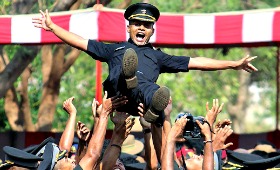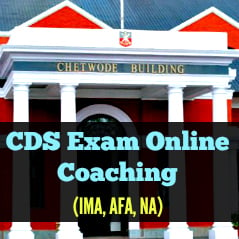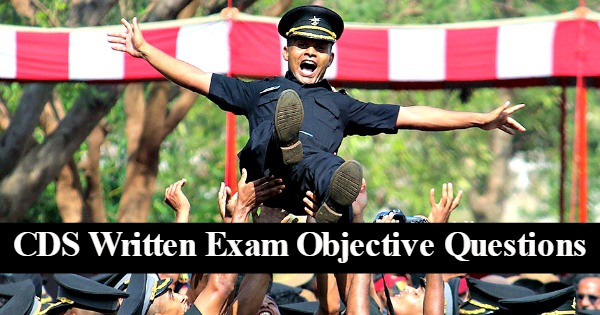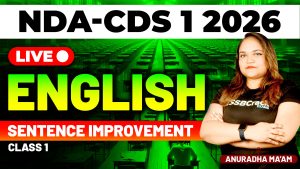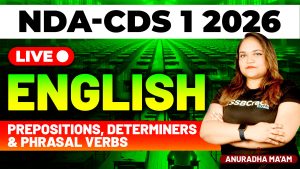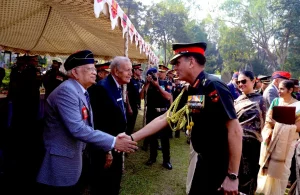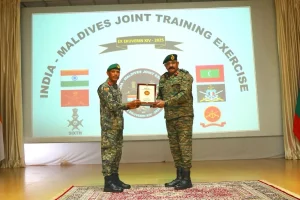CDS 2 2016 exam is going to be conducted in the month of November by UPSC. Candidates preparing for stream IMA NA AFA or only OTA both have to attend the written exam for CDS 2 2016 entry, In this article we will see some CDS Written Exam Objective Questions from previous years CDSE exam question papers.
CDS Written Exam Objective Questions
Elementary Mathematics
1. A rectangular paper of 44 cm long and 6 cm wide is rolled to form a cylinder of height equal to width of the paper. The radius of the base of the cylinder so rolled is
(a) 3 . 5 cm
(b) 5 cm
(c) 7 cm
(d) 14 cm
2. The diagonals of a trapezium are at right angles, and the slant sides, if produced, form an equilateral triangle with the greater of the two parallel sides. If the area of the trapezium is 16 square cm, then the distance between the parallel sides is
(a) 2 cm
(b) 4 cm
(c) 8 cm
(d) Cannot be determined due to insufficient data
3. From a circular piece of cardboard of radius 3 cm, two sectors of 40 degrees each have been cut off. The area of the remaining portion is
(a) 11 square cm
(b) 22 square cm
(c) 33 square cm
(d) 44 square cm
4. The sides of a triangle are 25 cm, 39 cm and 56 cm. The perpendicular from the opposite vertex on the side of 56 cm is
(a) 10 cm
(b) 12 cm
(c) 15 cm
(d) 16 cm
5. There is 60 percent increase in an amount in 6 years at simple interest. What will be the compound interest on rupees 12,000 after 3 years at the same rate of interest?
(a) Rs 2,160
(b) Rs 3,120
(c) Rs 3,972
(d) Rs 6,240
6. In how much time would the simple interest on a principal amount be 0.125 times the principal amount at 10 percent per annum?
(a) 1(1/4) years
(b) 1(3/4) years
(c) 2(1/4) years
(d) 2(3/4) years
7. 16 litres of a mixture contains milk and water in the ratio 5 : 3. If 4 litres of milk is added to this mixture, the ratio of milk to water in the new mixture would be
(a) 2 : 1
(b) 7 : 3
(c) 4 : 3
(d) 8 : 3
8. A man rows downstream 32 km and 14 km upstream, and he takes 6 hours to cover each distance. What is the speed of the current?
(a) 0. 5 km/hr
(b) 1 km/hr
(c) 1. 5 km/hr
(d) 2 km/hr
9. A car travels the first one-third of a certain distance with a speed of 10 km/hr, the next one-third distance with a speed of 20 km/hr and the last one-third distance with a speed of 60 km/hr. The average speed of the car for the whole journey is
(a) 18 km /hr
(b) 24 km/hr
(c) 30 km/hr
(d) 36 km/hr
General English
- Neither of the two boys (a)/ is sensible (b)/ enough to do this job. (c)/ No error (d)
Answer (d) The sentence is correct. - They left (a)/ their luggages (b)/ at the railway station. (c)/ No error (d)
Answer (b) Use ‘luggage’ in place of luggages. Luggage is an uncountable noun. - You will get (a)/ all the informations (b)/ if you read this booklet carefully. (c)/ No error (d)
Answer (b) Use ‘information’ in place of informations. Information is an uncountable noun. - She sang (a)/ very well, (b)/ isn‘t it ? (c)/ No error (d)
Answer (c) It should be ‘didn’t she’. The sentence is in Past Tense. - He is working (a)/ in a bank in New Delhi (b)/ for the past several months. (c)/ No error (d)
Answer (a) Use ‘has been’ in place of ‘is’. The sentence is in Present Perfect Continuous Tense. - He had lost a ring in the sand and (a)/ I helped him search for it, (b)/ but it was like a look for a
needle in a haystack. (c)/ No error (d)
Answer (b) There is no need to use ‘for‘ with search. Search itself implies to search for‘ lost ring in the sentence. - The Ganges and (a)/ it‘s tributaries constitute (b)/ one of the largest river-systems in the world. (c)/ No error (d)
Answer (b) It‘s is always the abbreviation of ‘it is’ as in ‘it‘s (= it is) a nice day, isn‘t it?’ Its is the
possessive of ‘it’ as in, ‘That is Mohan‘s cat but I don‘t know its name.’ In the second sentence, its
means ‘belonging to it’. So, it should be the Ganges and its tributaries. - The sudden change (a)/ of place (b)/ effected her health. (c)/ No error (d)
Answer (a) For changing the place ‘change in place‘ is better usage than ‘change of place‘. As later one shows the shift or movement. See the usage There is a change in place of marriage venue. There is sudden change of moods after the heated discussion. - There are a number of people (a)/ of every class and nationality (b)/ who doubts the truth of his
statement. (c)/ No error (d)
Answer (c) ‘A number of people‘ is plural and verb-subject agreement should be there in part (c) of the sentence so ‘doubt‘ will replace the ‘doubts‘. - I like this book because the writer has explained (a)/ the reasons (b)/ of his failure truly. (c)/ No error (d)
Answer (d) There is no error in the sentence. - The minister announced (a)/ compensation for (b)/ the victims from the accident. (c)/ No error (d)
Answer (c) Use ‘of‘ in place of ‘from‘. - I should (a)/ have preferred (b)/ to go by myself. (c)/ No error (d)
Answer (d) The sentence is correct. - There is (a)/ no place (b)/ in this compartment. (c)/ No error (d)
Answer (b) Use ‘room‘ or ‘seat‘ in place of ‘place‘. - The (a)/ young man (b)/ had no manner. (c)/ No error (d)
Answer (c) Say ‘had no manners‘. - There are many (a)/ beautiful furnitures (b)/ in the room. (c)/No error (d)
Answer (b) Use ‘articles of furniture‘ in place of ‘furnitures‘.
Passage 1
Light is made up of electromagnetic waves. These vary in length and it is these differences that we perceive as different colours. White light has all the wavelengths of the light spectrum mixed up together. An object looks coloured because light falls on it and it reflects only certain parts of the spectrum. The rest of the spectrum is absorbed by the object. An object that looks white reflects all the light that falls on it. An object that looks red reflects the red part of the spectrum and absorbs the rest. Our eyes detect these different reflected waves and we see them as different colours.
- Without colours we would consider the world a dull and less beautiful place.
- True
- False
- Cannot tell
- White light is an amalgam of all the wave lengths of light.
- True
- False
- Cannot tell
- The passage states that an object that looks blue absorbs all but the blue wavelengths of light.
- True
- False
- Cannot tell
- The colour we perceive an object to be is determined by the electromagnetic waves that it absorbs or reflects.
- True
- False
- Cannot tell
- White paint reflects more light than red paint.
- True
- False
- Cannot tell
Answers
- (c) 2. (a) 3. (b) 4. (a) 5. (a)
Passage 2
Traditionally medicine was the science of curing illness with treatments. For thousands of years people would have used plants and would have turned to priests for cures. In more recent times illness has been attributed less to the intervention of gods or magic and instead to natural causes. Medicine today is as much concerned with prevention as cure. Doctors use treatments of many types, including radiation and vaccination, both of which were unknown until very recent times. Other treatments have been known about and practiced for centuries. Muslim doctors were skilled surgeons and treated pain with opium. When Europeans first reach the Americas they found healers who used many plants to cure illnesses. The Europeans adopted many of these treatments and some are still effective and in use today.
- Modern medicine is the science of curing illness.
- True
- False
- Cannot tell
- Medicine is a science that owes its success to modern treatments.
- True
- False
- Cannot tell
- Vaccination is a relatively recent discovery.
- True
- False
- Cannot tell
- The author of the passage believes that prevention is better than cure.
- True
- False
- Cannot tell
- Practitioners of modern medicine make use of many techniques and technologies.
- True
- False
- Cannot tell
Answers
- (b) 2. (b) 3. (a) 4. (c) 5. (a)
Passage 3
In tropical rainforests the climate remains hot and damp all the year round. In the artic it is cold all year and high up in mountain ranges the climate is much colder than in nearby low lying lands. Climate is not the same as weather. The weather can change quickly whereas the climate describes the likely weather conditions over a much longer period of time. The world is divided into five climate zones. Polar is the only zone where it is always cold, tropical where it is hot all year round, temperate where there are warm summers and cold winters, desert where it is dry and cool, and forest where the summers are cool and short. Great climate changes have occurred, an example of which is the last ice age. Mankind can affect climate when, for example, he causes great forest fi res that create so much smoke that the sun is obscured for months, cooling a region. More recently man has affected the climate as a result of pollution from industry causing the earth to warm through what is called the greenhouse effect.
- The passage states that the weather in high mountain ranges is cooler than in nearby low lying areas.
- True
- False
- Cannot tell
- The passage describes how climate can change.
- True
- False
- Cannot tell
- In a tropical rainforest the climate is the same winter and summer.
- True
- False
- Cannot tell
- In deserts the winter is cooler than the summer.
- True
- False
- Cannot tell
- You can infer from the passage that the artic is a polar climate zone.
- True
- False
- Cannot tell
Answers
- (b) 2. (a) 3. (a) 4. (c) 5. (a)
General Knowledge
Q. Plants contains variety of sterols like stigma-sterol. ergosterol, sitosterol etc., which very closely resemble cholesterol. This plant sterols refered as
(a) Phytosterols
(b) CaIci ferols
(c) Ergocalci ferols
(d) Lumisterols
With which one of the following countries, India has signed a MoU under the International Cooperation on Brahmaputra and Satluj rivers?
(a) Pakistan
(b) China
(c) Bangladesh
(d) Nepal
Q. Headquarters of which one among the following Railway Zones in India is situated at the highest elevation from the mean sea level
(a) East Central Railway
(b) South Eastern Railway
(c) South Western Railway
(d) West Central Railway
Q. Stalactites and stalagmites are features of:
(a) glacial topography
(b) volcanic topography
(c) karst topography
(d) fluvial topography
Q. Which one of the following is the correct sequence of the given planets in increasing order of their site (diameter)?
(a) Mars – Venus – Earth – Mercury -Uranus
(b) Mercury – Mars – Venus – Earth -Uranus
(c) Mercury – Mars – Venus – Uranus -Earth
(d) Venus – Mercury – Mars – Earth –Uranus
Q. In artificial insemination (Al) process, which of the following is / are introduced into the uterus of the female?
(a) Egg only
(b) Fertilized egg
(c) Sperm only
(d) Egg and sperm
Q. Genetically modified (GM) crops contain modified genetic material due to
- introduction of new DNA
- removal of existing DNA
- introduction of RNA
- introduction of new traits
Select the correct answer using the code given below:
(a) 1and 2 only.
(b) 1 2 and 3
(c) 3 and 4
(d) 1 2 and 4
Q. Which one of the following statements is correct? The velocity of sound:
(a) does not depend upon the nature of media
(b) is maximum in gases and minimum in liquids
(c) is maximum in solids and minimum in liquids
(d) is maximum in solids and minimum in gases
Q. Which one of the following statements is not correct?
(a) Sound waves in gases are longitudinal in nature
(b) Sound waves having frequency below 20 Hz are known as ultrasonic waves
(c) Sound waves having higher amplitudes are louder
(d) Sound waves with high audible frequencies are sharp
Q. Which one of the following vitamins has a role in blood clotting?
(a) Vitamin A
(b) Vitamin B
(c) Vitamin
(d) Vitamin K
Q. Vitamin B12 deficiency causes pernicious anemia. Animals cannot synthesize vitamin B12, Humans must obtain all their vitamin B12 from their diet. The complexing metal ion in vitamin B12 is :
(a) Mg2+ (Magnesium ion)
(b) Fe2+ (Iron ion)
(c) Co3+ (Cobalt ion)
(d) Zn2+ (Zinc ion)
Q. Consider the following statements:
- Most of the coal and the ferrous group of minerals in India occur in the peninsula, south of the Vindhyas
- The peninsular India once formed part of the super-continent which included Australia, Antarctica, Africa and South America
Which of the statements given above is / are correct
(a) I only
(b) 2 only
(c) Both 1 and 2
(d) Neither 1 nor 2
Q. The Mahatma Gandhi National Marine Park is located in
(a) Pirotan Island
(b) Rameswaram
(c) Ganga Sagar Island
(d) Port Blair
Q. Which of the following statements is / arc correct ?
- The earth is nearest to the Sun at Perihelion, which generally occurs on January 3
- The earth is farthest away from the Sun at Perihelion, which generally occurs on July 4
- The earth is farthest away from the Sun at Aphelion, which generally occurs on July 4
- The earth is nearest to the Sun at Aphelion, which generally occurs on January 3
Select the correct answer using the code given below:
(a) I only
(b) 2 and 4
© I and 3
(d) 1 and 2
Q. Which one of the following islands is of volcanic origin?
(a) Reunion island
(b) Andaman & Nicobar islands
(c) Lakshadweep islands
(d) Maldives
Q. Glucose is a source of energy. Which one of the following types of molecules is Glucose?
(a) Carbohydrate
(b) Protein
© Fat
(d) Nucleic Acid
Q. The living content of cell is called protoplasm. It is composed of
(a) Cytoplasm only
(b) Cytoplasm and nucleoplasm
© Nucleoplasm only
(d) Cytoplasm, nucleoplasm and other organelles
Q. Norman Borlaug won Nobel Peace prize for his contributions in
- development of high yielding crops
- modernization of irrigation
- introduction to synthetic fertilizers find pesticides.
Select the correct answer using the code given below:
(a) I only
(b) 2 only
(c) 2 and 3 only
(d) I, 2 and 3
Q. A myopic person has a power or -1.25 Diopter. What in the focal length and nature of his lens?
(a) 50 cm and convex lens
(b) 80 cm and convex lens
(c) 50 cm and concave lens
(d) 80 cm and concave lens
Q. A piece of ice, 100 gm in mass is kepi at 00C. The amount of heat it requires to melt at °C is (take Intent heat of melting of ice to be 333.6 J/g):
(a) 750.6 J
(b) 83.4 J
(c) 33360 J
(d) 3.336
Q. Which one of the following hormones /contains peptide chain’
(a) Oxytocin
(b) Corticotropin
(b) Insulin
(d) Cortisone
Q. Which one of the following is an example of the chemical change?
(a) Burning of paper
(b) Magnetization of soil iron
(c) Dissolution of cane sugar in water
(d) Preparation of ice cubes from water
Q. Which one of the following is the cause of long-term sea-level change?
(a) Atmospheric disturbance
(b) Change in marine water density
© Melting of icebergs
(d) Melting of ice sheets
Q. Consider the following tributaries of river
Brahmaputra :
- Lohit
- Tista
- Subansiri
- Sankosh
Arrange the above rivers from west to cast:
(a) 2-4-3-1
(b) 2-3-4-1
(c) 4-2-3-I
(4} 3-1-2-4
Q. Which one of the following is the reason due to which the wind in the southern hemisphere is deflected towards its left?
(a) Difference in the water masses of northern and southern hemisphere
(b) Temperature and pressure variations
© Inclined axis of the Earth
(d) Rotation of the earth
Q. The ‘eye’ cyclone has :
(a) abnormally high temperature and lowest pressure
(b) abnormally low temperature and pressure
(c) clear sky and lowest temperature
(d) dense cloud cover and low pressure
